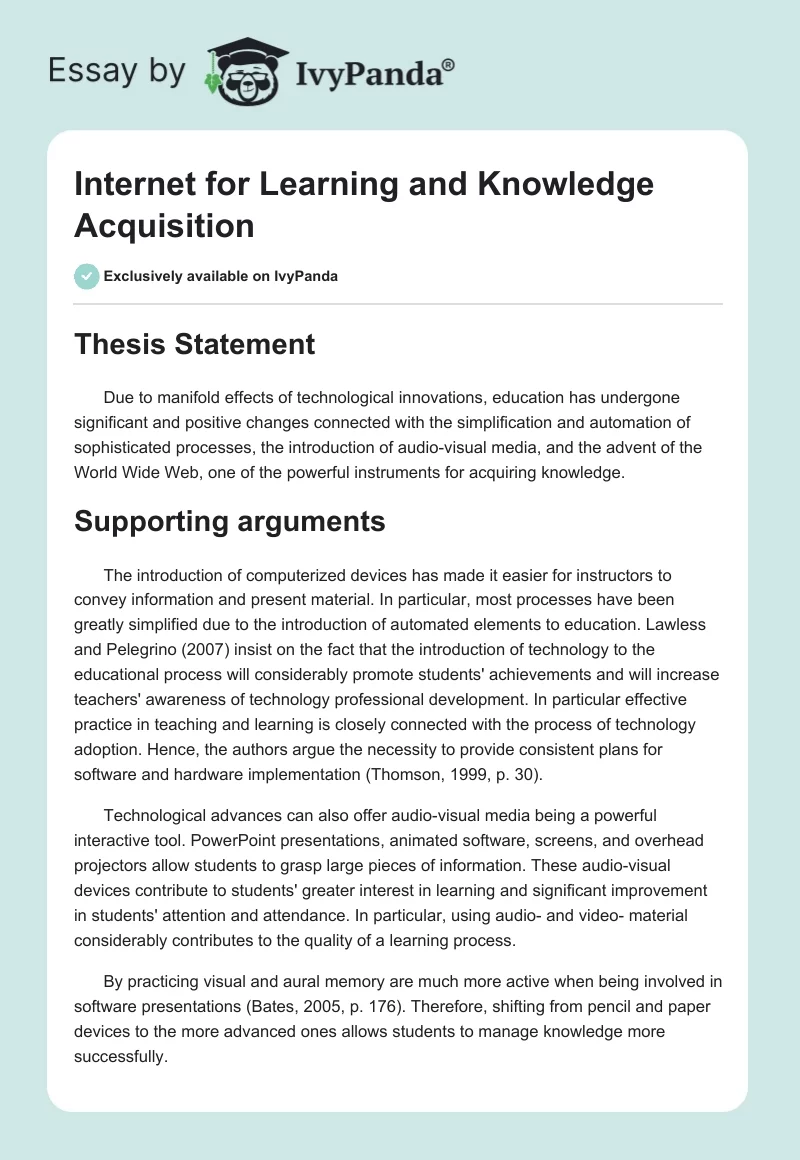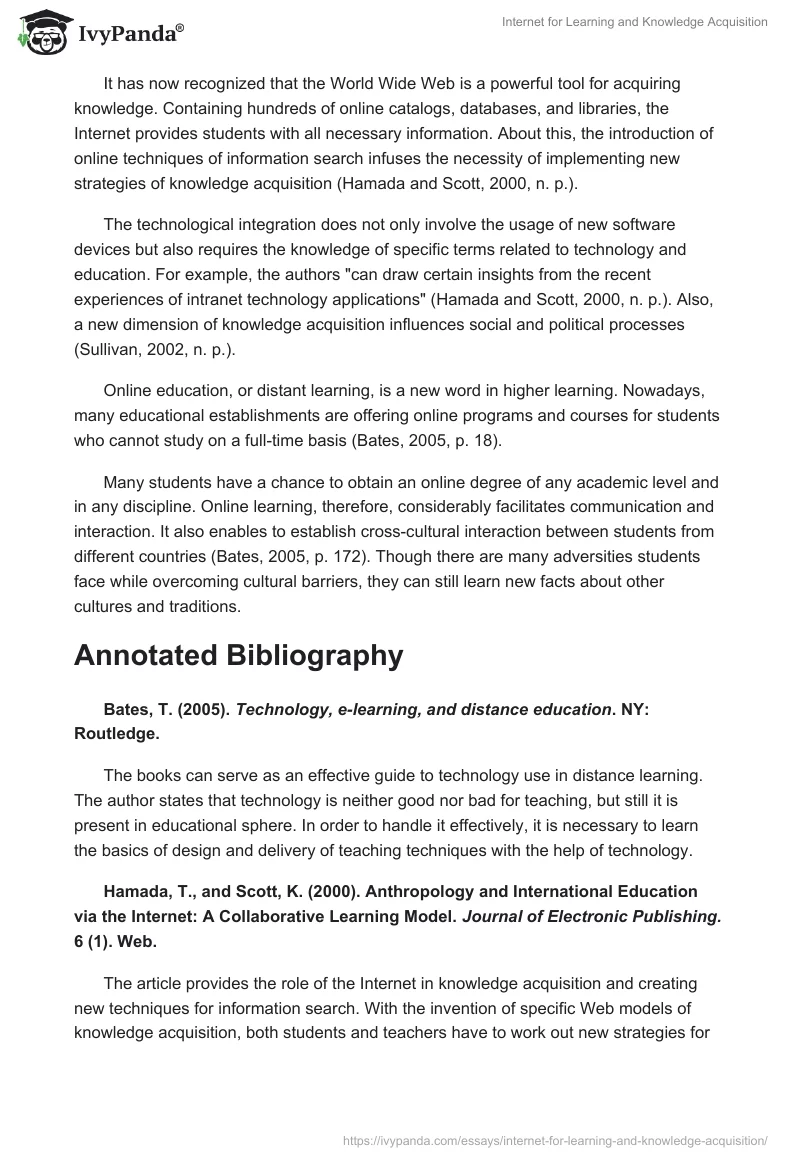Thesis Statement
Due to manifold effects of technological innovations, education has undergone significant and positive changes connected with the simplification and automation of sophisticated processes, the introduction of audio-visual media, and the advent of the World Wide Web, one of the powerful instruments for acquiring knowledge.
Supporting arguments
The introduction of computerized devices has made it easier for instructors to convey information and present material. In particular, most processes have been greatly simplified due to the introduction of automated elements to education. Lawless and Pelegrino (2007) insist on the fact that the introduction of technology to the educational process will considerably promote students’ achievements and will increase teachers’ awareness of technology professional development. In particular effective practice in teaching and learning is closely connected with the process of technology adoption. Hence, the authors argue the necessity to provide consistent plans for software and hardware implementation (Thomson, 1999, p. 30).
Technological advances can also offer audio-visual media being a powerful interactive tool. PowerPoint presentations, animated software, screens, and overhead projectors allow students to grasp large pieces of information. These audio-visual devices contribute to students’ greater interest in learning and significant improvement in students’ attention and attendance. In particular, using audio- and video- material considerably contributes to the quality of a learning process.
By practicing visual and aural memory are much more active when being involved in software presentations (Bates, 2005, p. 176). Therefore, shifting from pencil and paper devices to the more advanced ones allows students to manage knowledge more successfully.
It has now recognized that the World Wide Web is a powerful tool for acquiring knowledge. Containing hundreds of online catalogs, databases, and libraries, the Internet provides students with all necessary information. About this, the introduction of online techniques of information search infuses the necessity of implementing new strategies of knowledge acquisition (Hamada and Scott, 2000, n. p.).
The technological integration does not only involve the usage of new software devices but also requires the knowledge of specific terms related to technology and education. For example, the authors “can draw certain insights from the recent experiences of intranet technology applications” (Hamada and Scott, 2000, n. p.). Also, a new dimension of knowledge acquisition influences social and political processes (Sullivan, 2002, n. p.).
Online education, or distant learning, is a new word in higher learning. Nowadays, many educational establishments are offering online programs and courses for students who cannot study on a full-time basis (Bates, 2005, p. 18).
Many students have a chance to obtain an online degree of any academic level and in any discipline. Online learning, therefore, considerably facilitates communication and interaction. It also enables to establish cross-cultural interaction between students from different countries (Bates, 2005, p. 172). Though there are many adversities students face while overcoming cultural barriers, they can still learn new facts about other cultures and traditions.
Annotated Bibliography
Bates, T. (2005). Technology, e-learning, and distance education. NY: Routledge.
The books can serve as an effective guide to technology use in distance learning. The author states that technology is neither good nor bad for teaching, but still it is present in educational sphere. In order to handle it effectively, it is necessary to learn the basics of design and delivery of teaching techniques with the help of technology.
Hamada, T., and Scott, K. (2000). Anthropology and International Education via the Internet: A Collaborative Learning Model. Journal of Electronic Publishing. 6 (1). Web.
The article provides the role of the Internet in knowledge acquisition and creating new techniques for information search. With the invention of specific Web models of knowledge acquisition, both students and teachers have to work out new strategies for handling the academic process. The article also provides the essentials of knowledge acquisition and the influence of social changes to this process.
Lawless, K. and Pellegrino, J. W. (2007). Professional Development in Integrating into Teaching and Learning: Knowns, Unknowns, and Ways to Pursue Better Questions and Answers. Review of Educational Research. 77(4), pp. 575-614.
In the article, the author discusses the phenomenon of technology integration into teaching and learning as well as to what extent this process increases the effectiveness of educational achievements. In addition, the article provides an evaluation plan presenting the pertinent information needed for better comprehension of important educational problems within technological content.
Sullivan, M. F. (2002). Of Victories and Ventures – Editorial. Technos: Quaterly for Education and Technology.
The editorial article describes a political view on integrating technologies in education. In particular, it considers the necessity to use technological innovations for equipping schools. According to the author, the introduction of software and hardware is a necessary financial contribution to the educational sphere.
Thomson, H. (1999). The Impact of Technology and Distance Education: A Classical Learning. Educational Technology & Society 2(3) pp. 29-40.
According to the author, there is a close connection between education and social formations. In other words, the article emphasizes the role of social norms and values in determining the nature and character of education. Technology is one of those values. In addition, the author also believes that the educational and knowledge are under great influence of technologies that transforms theses spheres according to the existing technological mechanisms.
Summary of an Editorial Article
Summary of the Article
The article under consideration is called We Are the Press. You Know our Power and is written by Sullivan (2002). In his work, the editor expresses the idea that the Internet has fully captured the information sphere and has made the book production much easier that, in its turn, has decreased the role of the book production and financing. Referring to historical information about the origins of books production, Sullivan (2002) focuses that book manufacturing used to be under the influence of art. However, contemporary attitude to making books has nothing in common with aesthetics.
Critique of the Article
According to the author, the advent of the Internet has decreased the importance of book making due to the existence of electronic books. On the one hand, such situation prevents from considering books as items of art contributing the aesthetic value of those. On the other hand, the primary purpose of books is to provide information and experience to readers who want to get the information they need. In this respect, the author places an emphasis on the artistic value on books rather than on their informative value.
Though the aesthetic value of books was lost to some extent, the increasing availability of online book technologies positively contributes to improving the educational databases that have now expanded their online resources for readers all over the world (Cavanaugh, 2005, p. 2). An e-book, hence, is an effective educating tool for meeting students’ specific needs. What is more important, the introduction of new software devices is a new world in presenting descriptions and illustrations of the most popular book programs and platforms.
According to Cavanaugh (2005), if “reading may always be a constant in education, what may change is the way that we teach reading and the tools that we use” (p. 3). In other words, though electronic book requires the knowledge of specific reading techniques, the utilization of digital information is the step forward toward the technological and education advancement. Comparing this statement to the assumptions presented in the article, it should be noted that Sullivan is more concerned with the way the source is presented but not with what it actually presents.
Despite the discrepancies concerning the reasonableness of using electronic sources, there is still a problem with the protection of intellectual property, which is much more serious in the Web space. From this perspective, the usage of hardcover books is much more save and legal (Sullivan, 2002). Nevertheless, the problems exist in both spheres. The rise of the Internet has created much more space for developing a copyright system protecting the authenticity of electronic sources. What is more important is that students can use official and education sites that are protected enough from plagiarism.
In general, considering the Internet as powerful tool for educating and for acquiring knowledge, the form of information presentation becomes of secondary importance whereas the aesthetic value should be redirected at other than education spheres. The primary purpose of learning and teaching is increasing students’ performance and improving their results.
Reference List
Bates, T. (2005). Technology, e-learning and distance education. NY: Routledge.
Cavanaugh, T. W. (2005). The digital reader: using e-books in K-12 education. US: ISTE.
Hamada, T., and Scott, K. (2000). Anthropology and International Education via the Internet: A Collaborative Learning Model. Journal of Electronic Publishing. 6 (1). Web.
Lawless, K. and Pellegrino, J. W. (2007). Professional Development in Integrating into Teaching and Learning: Knowns, Unknowns, and Ways to Pursue Better Questions and Answers. Review of Educational Research. 77(4), pp. 575-614.
Sullivan, M. F. (2002). Of Victories and Ventures – Editorial. Technos: Quaterly for Education and Technology.
Sullivan, M. F. (2002). We Are the Press. You Know our Power Technos: Quaterly for Education and Technology.
Thomson, H. (1999). The Impact of Technology and Distance Education: A Classical Learning. Educational Technology & Society 2(3) pp. 29-40.


